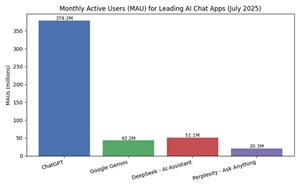Developer Offer
Try ImaginePro API with 50 Free Credits
Build and ship AI-powered visuals with Midjourney, Flux, and more — free credits refresh every month.
ChatGPT Expands To Google Cloud Solidifying AI Market Lead
A recent report from digital intelligence platform Similarweb confirms what many already suspected: OpenAI's ChatGPT is not just leading the generative AI race, it's dominating it. And with a new strategic expansion to Google Cloud infrastructure, that lead is set to grow even stronger.
ChatGPTs Unrivaled Market Dominance
The July 2025 usage data paints a clear picture of ChatGPT's commanding position in the market. The platform accounts for nearly 80% of all web traffic among the AI tools tracked. The numbers speak for themselves:
- Website Visits: 5.72 billion
- Monthly Active Users (App): 378.2 million
- Daily Stickiness: A remarkable 43.75%, meaning a high percentage of users return daily.
These engagement metrics are far beyond those of its nearest competitors, establishing ChatGPT as the go-to platform for a massive global user base.

A Strategic Expansion to Google Cloud
Fueling this growth, OpenAI has officially added Google Cloud Platform (GCP) to its list of sub-processors, a move widely reported by outlets like CNBC. This signals a significant diversification of its infrastructure, which already includes Microsoft Azure, Oracle Cloud, and CoreWeave. The expansion brings additional GPU capacity and extends its geographic reach to five new regions, including Japan and the Netherlands, specifically benefiting services like the API, ChatGPT Enterprise, ChatGPT Edu, and ChatGPT Team.
The Rise of Multi Cloud AI for Enterprises
For IT professionals and cloud architects, OpenAI's move is a clear signal that multi-cloud is the future of enterprise AI. This diversification has several direct benefits for businesses relying on OpenAI's models:
- Latency Optimization: Deploying on Google Cloud's regional infrastructure can reduce response times for users, a critical factor for customer-facing applications and internal automations.
- Improved GPU Access and Cost Management: By leveraging multiple cloud providers, OpenAI can secure more competitive GPU pricing and availability. This can lead to more stable performance and predictable API costs for enterprise customers.
- Enhanced Resilience and Redundancy: A multi-cloud architecture mitigates the risk of relying on a single provider, which is a crucial consideration for mission-critical systems and businesses in regulated industries.
As ChatGPT becomes more integrated into enterprise workflows, IT teams must prepare for deeper API integrations across multiple cloud platforms, affecting decisions on everything from network security to cost monitoring.
How Challengers Are Making Their Mark
While ChatGPT leads the pack, other AI tools are gaining traction in specific areas. Google Gemini, for instance, dominated mobile app downloads in July with 102.42 million installs, far ahead of ChatGPT's 62.86 million. This points to a strong mobile distribution strategy, especially within the Android ecosystem.
However, engagement tells a different story. Gemini’s daily stickiness was only 5.45%, a fraction of ChatGPT’s 43.75%. This gap suggests that while Gemini has massive reach, it has yet to build the same level of user habituation and deep integration as ChatGPT.
Other platforms are finding their niche. DeepSeek surpassed Gemini in monthly active users, and Perplexity boasts a high stickiness rate of 22.01%, indicating a loyal user base for research-focused tasks.
| AI Tool | Website Visits | MAUs (App) | Downloads | Rating | Daily Stickiness |
|---|---|---|---|---|---|
| ChatGPT | 5.72B | 378.2M | 62.86M | 4.67★ | 43.75% |
| Google Gemini | 699.6M | 43.18M | 102.42M | 4.60★ | 5.45% |
| DeepSeek | 350.4M | 51.13M | 2.76M | 4.28★ | 19.45% |
| Perplexity | 140.6M | 20.27M | 7.07M | 4.61★ | 22.01% |
Source: Similarweb
A Global Look at AI Adoption
The United States remains the largest single market for ChatGPT, accounting for over 15% of its web traffic. This indicates deep integration into business operations, including:
- Customer Support: Automating responses to common inquiries.
- Marketing & Copywriting: Drafting promotional content and social media posts.
- Code Generation: Assisting developers with boilerplate code and debugging.
At the same time, growth is accelerating in mobile-first markets like India, Brazil, and Southeast Asia. This highlights the need for global AI strategies to focus on mobile user experience, localization for regional dialects, and compliance with varying data regulations.
Actionable Insights for Tech Leaders
As the generative AI landscape matures, it’s clear that a one-size-fits-all approach is no longer sufficient. Limor Barenholtz, Director of SEO at Similarweb, advises that "businesses should tailor AI adoption strategies to regional conditions, focusing on localization, regulatory compliance, and user engagement."
For enterprise IT and development teams, this means evaluating platforms based on a more nuanced set of criteria:
- Engagement vs. Reach: Look beyond download numbers. Daily stickiness is a better indicator of a tool's long-term value.
- API Ecosystem Maturity: Consider the robustness of developer tools, plugins, and enterprise support when choosing a platform.
- Infrastructure Alignment: With OpenAI now on a multi-cloud footing, it's time to rethink your own network architecture and cost models to best leverage these powerful tools.
Compare Plans & Pricing
Find the plan that matches your workload and unlock full access to ImaginePro.
| Plan | Price | Highlights |
|---|---|---|
| Standard | $8 / month |
|
| Premium | $20 / month |
|
Need custom terms? Talk to us to tailor credits, rate limits, or deployment options.
View All Pricing Details

